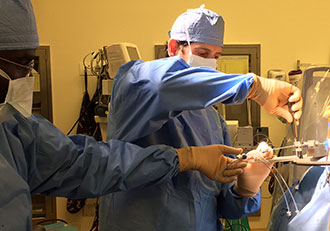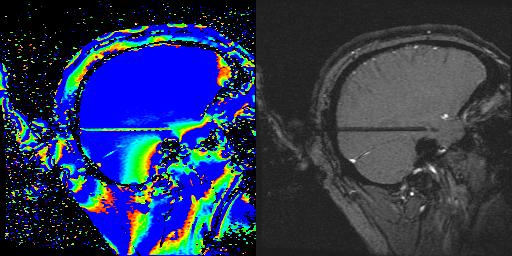
Dr. Theodore Schwartz and Dr. Michael Kaplitt recently collaborated on the care of a patient with epilepsy using an advanced laser ablation technology to remove the lesion that had been causing the seizures. The neurosurgeons at the Weill Cornell Brain and Spine Center have been using this laser technology, called Visualase, for the past year to treat brain tumors, but this was the first time they had used it in a patient with epilepsy.
Laser ablation uses light delivered through a laser applicator to heat a target and destroy it. The procedure is performed under MRI guidance to ensure precise placement of the laser. Neurosurgeons monitor the process on temperature maps that display the exact area being heated and the temperature reached, which allows them to destroy as much of the lesion as possible with minimal effects on the healthy brain tissue that surrounds it.
In the recent epilepsy procedure, Drs. Schwartz and Kaplitt delivered three ablations to destroy the entire seizure focus, which consisted of the amygdala and hippocampus. The treatment within the MRI scanner took approximately 25 minutes.
The laser raised the temperature of the tissue to more than 40 degrees Celsius (over 100 degrees Fahrenheit) for three minutes, causing cell death. In the animations below, you can see the temperature change along the path of the laser as well as the tumor itself as it heats. The path, however, is so small that the laser does not damage healthy brain tissue on its way to the target.

 A patient who undergoes laser ablation typically has a very small incision, requiring only a single stitch to close, with minimal shaving of the hair around the incision. Hospital stays are short, usually only a day or two, compared with much longer stays after open surgery. And since laser ablation uses light instead of radiation, there are none of the possible side effects of radiation.
A patient who undergoes laser ablation typically has a very small incision, requiring only a single stitch to close, with minimal shaving of the hair around the incision. Hospital stays are short, usually only a day or two, compared with much longer stays after open surgery. And since laser ablation uses light instead of radiation, there are none of the possible side effects of radiation.
The Visualase laser ablation system is only one of several new advanced technologies now available to patients at NewYork-Presbyterian/Weill Cornell Medical Center, including a new linear accelerator for delivery of stereotactic radiosurgery, a new intra-operative navigation system used for improved precision in spinal surgery, and a new MRI-guided focused ultrasound
More about Minimally Invasive Neurosurgery